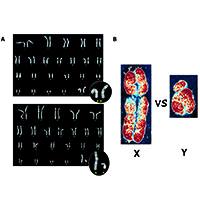RILEVANZA DEL SESSO NELLA MALATTIA DA COVID-19: QUANDO UN CROMOSOMA IN PIÙ FA LA DIFFERENZA!
DOI:
https://doi.org/10.4081/scienze.2021.774Abstract
Meta-analysis of epidemiological world-wide reports of SARS-CoV-2 patients requiring mechanical ventilation in intensive care units highlighted the male sex as a risk factor for severe, often fatal evolution of COVID-19 disease, as signaled by previous coronavirus infections. X chromosome inactivation (XCI), an epigenetic mechanism used by female somatic cells to equalize the dosage of X-linked genes between the sexes and the female advantage with mosaicism of the numerous immune-related genes and the increased expression of those escaping XCI determined a growing recognition of the unique biology of the X chromosome to account for females more robust immune response. In the wake of studies aimed at establishing the contribution of immune-regulatory X-linked genes to sex-specific differences of COVID-19 disease, the expression of TLR7, a gene of innate immune response encoding a member of Toll-like family receptors sensing the SARS-CoV-2 endosomal RNA, has been quantified in human female plasmacytoid dendritic cells which are high producers of interferons, acting as powerful viral inhibitors. The study confirmed that TLR7 escapes XCI promoting higher TLR7 mRNA and higher interferon mRNA at the single-cell level. The relevance of TLR7 signaling has been highlighted by a Dutch study exploring the presence of genetic variants among young men with severe COVID-19 which identified pathogenic TLR7 variants in two pairs of brothers (mean age 26 years) without medical history admitted to intensive care units due to SARS-CoV-2 acute respiratory syndrome, one of whom deceased due to septic shock. Whole exome sequencing of the patients identified “loss of function variants” of the X-chromosomal TLR7 and functional studies on their peripheral blood mononucleate cells after in vitro stimulation with a TLR7 agonist showed significant reduction of TLR7-specific mRNA and decreased mRNA expression of various interferon type I genes as compared to family members and controls. While rare mutations in TLR7 are unlikely to be a major drive of severe COVID-19 disease, their identification begins to unravel the molecular underpinning of COVID-19 infection highlighting TLR7 receptor as a critical node in recognizing SARS-CoV-2 and initiating an early immune response to clear the virus and prevent the development of COVID-19.
Downloads


